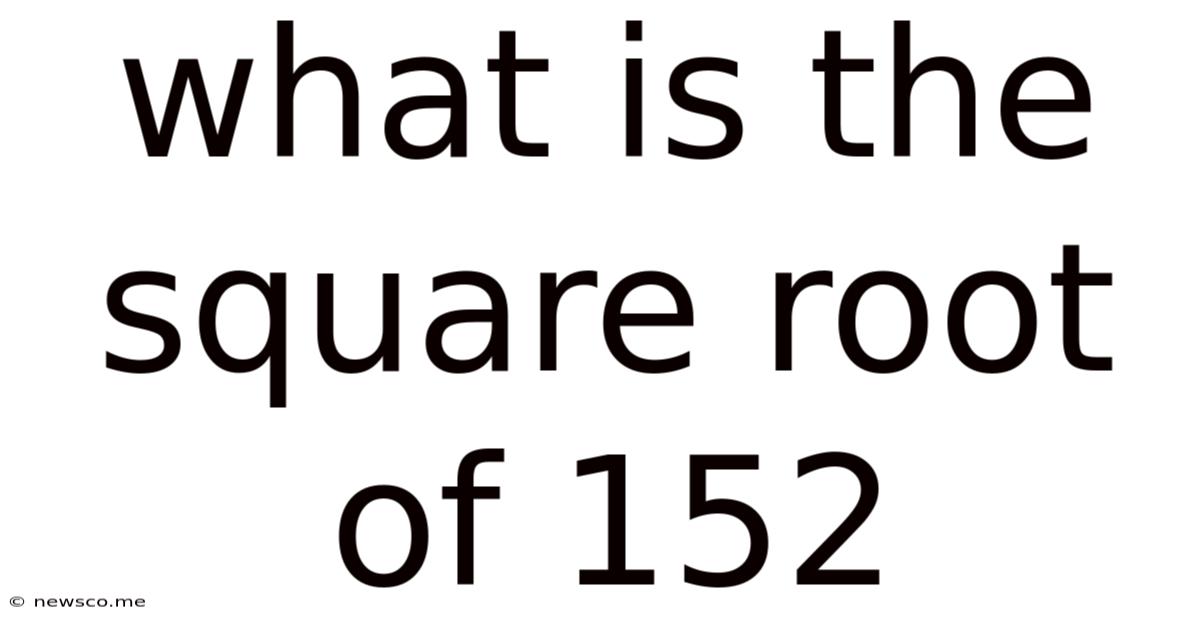What Is The Square Root Of 152
News Co
Apr 13, 2025 · 5 min read

Table of Contents
What is the Square Root of 152? A Deep Dive into Square Roots and Approximation Techniques
The seemingly simple question, "What is the square root of 152?" opens a door to a fascinating world of mathematical concepts and techniques. While a calculator readily provides a decimal approximation, understanding the underlying principles and methods for finding square roots offers valuable insight into numerical analysis and mathematical problem-solving. This article will explore various approaches to finding the square root of 152, from basic estimation to advanced algorithms, demonstrating the richness and depth of this seemingly straightforward calculation.
Understanding Square Roots
Before diving into the specifics of calculating √152, let's establish a firm understanding of what a square root represents. The square root of a number, denoted as √x, is a value that, when multiplied by itself (squared), equals the original number, x. In other words, if y = √x, then y * y = x.
For perfect squares (numbers that are the product of an integer multiplied by itself, like 4, 9, 16, etc.), finding the square root is straightforward. However, for numbers like 152, which is not a perfect square, the square root is an irrational number – a number that cannot be expressed as a simple fraction and continues infinitely without repeating.
Estimating √152: The Intuitive Approach
Before relying on calculators or complex algorithms, let's attempt a rough estimation. We know that 12² = 144 and 13² = 169. Since 152 falls between 144 and 169, we can reasonably deduce that the square root of 152 lies between 12 and 13. This provides a starting point for more refined calculations.
Method 1: Babylonian Method (Heron's Method)
The Babylonian method, also known as Heron's method, is an iterative algorithm that refines an initial guess to progressively approximate the square root. It's remarkably efficient and converges quickly to a solution.
Steps:
-
Make an initial guess: Based on our estimation, let's start with x₀ = 12.5 (midpoint between 12 and 13).
-
Iterate: The formula for iteration is: xₙ₊₁ = 0.5 * (xₙ + 152/xₙ)
-
Repeat: We continue this process, substituting the result of each iteration back into the formula until the desired level of accuracy is achieved.
Let's perform a few iterations:
- Iteration 1: x₁ = 0.5 * (12.5 + 152/12.5) ≈ 12.328
- Iteration 2: x₂ = 0.5 * (12.328 + 152/12.328) ≈ 12.3288
- Iteration 3: x₃ = 0.5 * (12.3288 + 152/12.3288) ≈ 12.3288
Notice how quickly the value converges. After just a few iterations, we have a highly accurate approximation of √152 ≈ 12.3288.
Method 2: Newton-Raphson Method
The Newton-Raphson method is another iterative approach to finding the square root. It's closely related to the Babylonian method and offers similar convergence properties. The core idea involves using the tangent line of a function to approximate the root.
For finding the square root of a number 'a', the Newton-Raphson formula is:
xₙ₊₁ = 0.5 * (xₙ + a/xₙ)
This is essentially the same formula as the Babylonian method. The choice between these methods often comes down to personal preference or the specific context of the problem.
Method 3: Using Logarithms and Exponentials
A less intuitive but mathematically sound approach involves using logarithms and exponentials. The relationship between logarithms and exponents allows us to transform the square root operation into an easier calculation.
Remember that √a = a^(1/2). Using the properties of logarithms, we can rewrite this as:
log(√a) = log(a^(1/2)) = (1/2) * log(a)
By calculating the logarithm of 152, dividing by 2, and then finding the antilogarithm (exponential), we can obtain the square root. This method requires access to logarithmic tables or a calculator with logarithmic functions.
Method 4: Continued Fractions
Continued fractions provide another fascinating way to represent irrational numbers like √152. A continued fraction expresses a number as a sum of a whole number and the reciprocal of another number, which in turn is expressed as a sum of a whole number and a reciprocal, and so on. While the process is more involved than the iterative methods described above, it provides a unique representation of the square root.
Understanding the Limitations of Approximations
It's crucial to remember that all the methods described above yield approximations of √152. The square root itself is an irrational number, meaning its decimal representation is infinite and non-repeating. The accuracy of the approximation depends on the number of iterations performed or the precision of the tools used (calculators, logarithmic tables, etc.).
The Importance of Accuracy in Different Contexts
The level of accuracy required for the square root of 152 depends entirely on the context. In some applications, a rough estimate might suffice. For example, in a simple geometric calculation, rounding to the nearest whole number (12) might be acceptable. However, in scientific or engineering applications, much higher precision might be essential, requiring numerous iterations of the Babylonian or Newton-Raphson methods or the use of specialized software.
Conclusion: More Than Just a Number
The quest to find the square root of 152 is far more than a simple arithmetic exercise. It's a journey into the heart of numerical analysis, highlighting the elegance and power of iterative methods and showcasing the richness and depth of mathematical concepts. By understanding the various approaches and their limitations, we appreciate the complexities and subtleties inherent in seemingly straightforward calculations. The choice of method depends largely on the desired level of accuracy, the tools available, and the context of the problem. Regardless of the approach taken, the exploration itself provides valuable insights into the fascinating world of mathematics.
Latest Posts
Related Post
Thank you for visiting our website which covers about What Is The Square Root Of 152 . We hope the information provided has been useful to you. Feel free to contact us if you have any questions or need further assistance. See you next time and don't miss to bookmark.